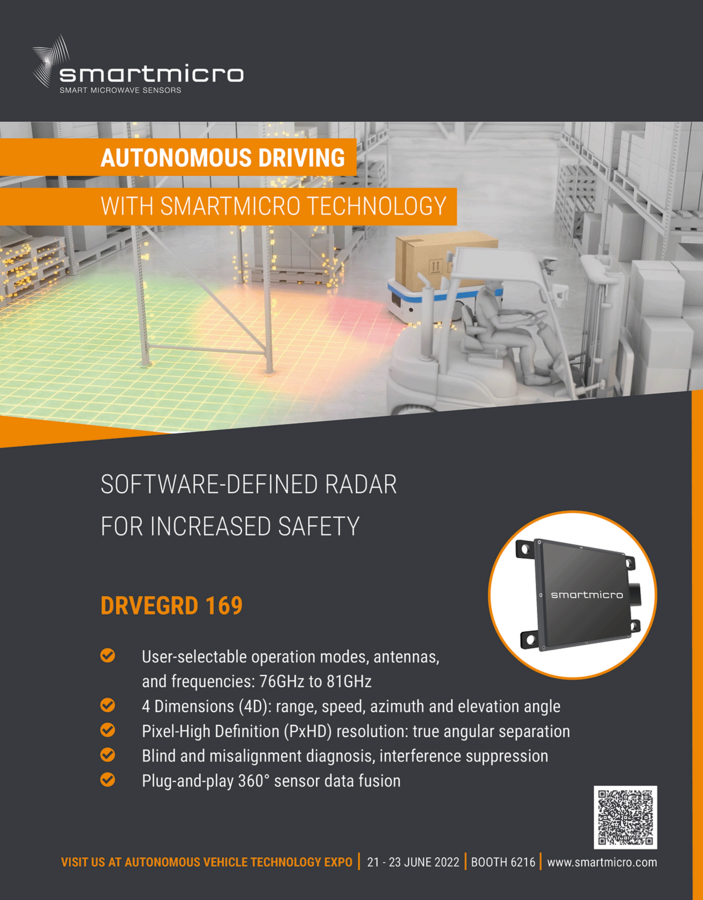Vision zero
A new software-defined radar is ideal for ADAS and autonomous driving applications
This article was originally published in ADAS & Autonomous Vehicle International Magazine (April 2022). You can preview the original version here (click).
One of the main motivations for all those working to achieve automated driving is to help prevent accidents, injuries and fatalities. Automotive sensors have a key role to play in enhancing driving safety. With the right sensor technology, accidents are avoided by detecting potential collisions, triggering warning signals to alert the driver, and supporting automated safety functions. The higher the level of automation, the more the vehicles rely on advanced sensor technology to detect all objects in the surrounding environment. Covering the very close range around a vehicle in high resolution is crucial. The vehicle’s immediate surroundings can be complex and rarely allow all-around visibility for the driver.
For safe coverage of the area around the vehicle, smartmicro has developed a powerful, new software-defined radar – DRVEGRD 169. The 79GHz (76GHz to 81GHz) radar sensor offers different selectable software-defined operation modes, antennas and frequencies, to cover the field of view perfectly for each individual use case. The modes can be either remotely switched in real time during operation or set to automatic switching. The sensor provides a 140°+ field of view horizontally and 28° in elevation, and a maximum range of 130m is covered. Separation of objects with less than 10cm radial distance is possible. As such, the sensor is a perfect fit for autonomous parking and can also be used for autonomous shuttles or industrial delivery robots. Because of the sensor’s almost unbreakable design and its crucial advantage of being unaffected by harsh weather conditions, DRVEGRD 169 is also an ideal choice for construction or mining applications including heavy vehicles.
DRVEGRD 169 was developed in close cooperation with NXP and includes its latest 16nm-FinFET Radar MCU S32R29, as well as the latest RF CMOS Radar Transceiver TEF82xx. The new radar sensor has more than double the processing power, increased maximum range and higher resolution – targeting ASIL-B (SEooC) and NCAP compliance, which can be used universally in any safety-relevant on-road application. The sensor also interfaces with CAN FD and automotive Ethernet. Additionally, smartmicro provides ROS1 and ROS2 drivers as well an API for sensor configuration.
Use cases
This powerful sensor is a leap toward vision zero, made for industrial and autonomous applications including parking applications, robots and construction applications.
Parking applications – The National Safety Council discovered that in the USA alone, on average at least 60,000 people are injured and 500 or more die because of crashes in parking lots and garages every year. One of the reasons is the driver’s false sense of security when driving at a slow speed.
Fully autonomous robots – McKinsey states that globally the automation of warehouses increased by more than 10% each year from 2015 to 2019 and is expected to double by 2026. To ensure safety at workspaces with human-robot collaboration, high safety standards must be fulfilled by the autonomous vehicle and all integrated technology for autonomous driving.
Construction applications – According to Statista, 15% of fatal work-related accidents on construction sites in Germany in 2019 were caused by collisions with moving heavy construction vehicles. A reliable 360° coverage around fast-moving vehicles is necessary to ensure safety in the areas that are barely observable for the driver.
It is everyone’s aim in the autonomous sector to reduce and prevent accidents. Many of today’s safety risks – and with them, numerous injuries and fatalities – can be prevented through the use of highly effective warning systems triggered by the latest automotive radar technology.

